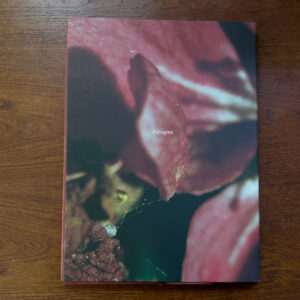JTF (just the facts): A total of 33 photographs made by 7 artists/photographers, variously framed and matted, and hung against white walls in the entry area and the smaller front gallery. The show was organized by Olivier Renaud-Clément.
The exhibit includes the following artists, with number of works, processes, dates, and other details as background:
- Matt Mullican: 3 color transparency (Duratran) and light box, 2004, sized roughly 17x21x5 inches, unique
- Helen Mirra: 1 set of 7 black and white photographs and text, 2014, each sized roughly 11×17 inches, unique
- James Welling: 5 dye transfer prints, 2020, each sized roughly 9×13 or 9×14 inches, unique
- Martin d’Orgeval: 1 daguerreotype, 2021, sized 20×16 inches
- Sherrie Levine: 2 sets of 5 archival giclée prints, 2021, each sized 20×16 inches (or the reverse), in editions of 5+1AP
- Liz Deschenes: 1 Fujiflex print diptych, 2001, each panel sized 26×19 inches, in an edition of 5+2AP
- Baron Louis-Adolphe Humbert de Molard: 5 original paper negatives (in illuminated vitrine), 1847, each sized roughly 7×10 or 8×10 inches, unique
(Installation shots below.)
Comments/Context: Back in 1847, the French photographer Baron Louis-Adolphe Humbert de Molard made a series of photographs at and near William the Conqueror’s Chateau de Falaise in Normandy. As a medium, photography was still very much in its experimental infancy at that time, and Humbert de Molard’s paper negatives from that visit are unexpectedly innovative. Wide views of the castle battlements situated amid the surrounding village are compositionally arranged as stacked layers, and the pictures slowly move inward in serial fashion, as if walking ever nearer, ultimately arriving at the rocky base of the hillside, where closer views of the cracks and contours of the rocks edge toward dramatic abstraction. They are the kind of 19th century photographs that crackle with precursors and hints of modern thinking.
The five calotypes on view here astonishingly stayed together for some 150 years until they were acquired by art dealer and collector Olivier Renaud-Clément. In this tightly considered group show (the fourth in an intermittent series spanning almost two decades and several different galleries), Humbert de Molard’s images provide the inspirational foundation for a range of responses by contemporary artists.
Sherrie Levine makes the most direct interaction with the original paper negatives. Since no known positives survive (or perhaps were ever made in the first place), Levine’s prints are a slightly different kind of rethinking than the appropriations she has made of photographs by Evans, Rodchenko, Weston, Stieglitz, and others. The works collapse both a sense of unlocking the distant past and a modern reimagining and reconceptualization the impact of those images through her own eyes, almost like mixing primary and secondary perspectives into one act of seeing.
The included works by Liz Deschenes and Helen Mirra find inspiration in Humbert de Molard’s telescoping vision. In photographing a green screen setup for video production, Deschenes moves from a stepped back documentary view that shows the room, the infrastructure, and the unrolled green background to a tight crop of the green material, turning it into an indefinite abstract color study. Mirra goes for a walk in Cape Breton, making images looking down at the ground underneath her feet as she goes, just as Humbert de Molard took his photographs of the chateau on his own wanderings more than a century earlier. Her black and white images notice the subtle details of the paths, the dirt, the grass, the flowers, and the weeds, and like his rocks, push them toward exercises in all over texture. Her photographs are then paired with short texts that add a poetic cadence to the rhythms of her movement.
James Welling and Martin d’Orgeval take more process-centric cues from Humbert de Molard’s calotypes. Welling draws on the French photographer’s use of experimental toning baths and chemical washes, in works made by soaking book pages in dye and pressing them onto photographic paper. Welling’s results are watery and ethereal, with ghosts of the images and texts on the pages wavering in and out of legibility. D’Orgeval turns back to another 19th century process, the daguerreotype, for his contribution to the show. In it, the massive dark orb of the sun glows with reversed hints of yellow and blue, almost like the nuanced gold tones found in Humbert de Molard’s prints.
Matt Mullican’s lightbox photographs of indeterminate digital spaces resonate most with Humbert de Molard’s tonal reversals. Mullican’s pictures glow with possible horizons, cloud banks, and misty brightness, but never quite resolve into something recognizable. Their inherent mystery makes a good match with the dark strangeness found in a few of Humbert de Molard’s negatives.
Seen together, the works in this modest group show are filled with much more richness of thinking than the small installation might normally signal. There are thoughtful links and connections to be discovered between Humbert de Molard’s prints and all of the included works, rewarding those who are intrigued by conceptual time traveling and want to dig deeper than a casual summer walkthrough.
Collector’s POV: The works in this show are priced as follows:
- Matt Mullican: $11000 each
- Helen Mirra: €25000 for the set of 7
- James Welling: $12000 each
- Martin d’Orgeval: $25000
- Sherrie Levine: $120000 for each set of 5
- Liz Deschenes: $50000 for diptych
- Baron Louis-Adolphe Humbert de Molard: NFS


















